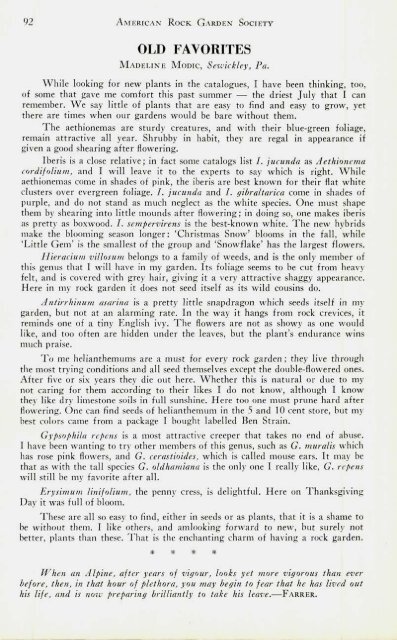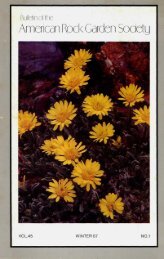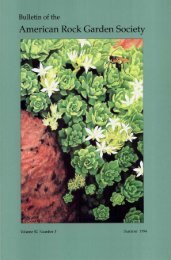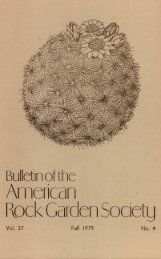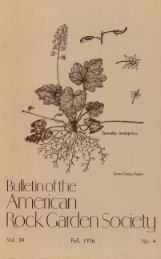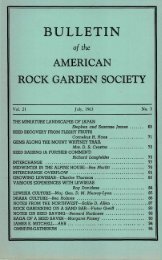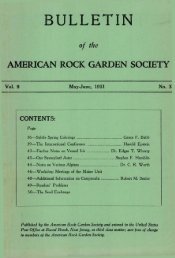Bulletin - July 1956 - North American Rock Garden Society
Bulletin - July 1956 - North American Rock Garden Society
Bulletin - July 1956 - North American Rock Garden Society
You also want an ePaper? Increase the reach of your titles
YUMPU automatically turns print PDFs into web optimized ePapers that Google loves.
92 AMERICAN ROCK GARDEN SOCIETYOLD FAVORITESMADELINE MODIC, Sewickley,Pa.While looking for new plants in the catalogues, I have been thinking, too,of some that gave me comfort this past summer — the driest <strong>July</strong> that I canremember. We say little of plants that are easy to find and easy to grow, yetthere are times when our gardens would be bare without them.The aethionemas are sturdy creatures, and with their blue-green foliage,remain attractive all year. Shrubby in habit, they are regal in appearance ifgiven a good shearing after flowering.Iberis is a close relative; in fact some catalogs list I. jucunda as Aethionemacordifolium, and I will leave it to the experts to say which is right. Whileaethionemas come in shades of pink, the iberis are best known for their flat whiteclusters over evergreen foliage. I. jucunda and I. gibraltarica come in shades ofpurple, and do not stand as much neglect as the white species. One must shapethem by shearing into little mounds after flowering; in doing so, one makes iberisas pretty as boxwood. I. sempervirens is the best-known white. The new hybridsmake the blooming season longer: 'Christmas Snow' blooms in the fall, while'Little Gem' is the smallest of the group and 'Snowflake' has the largest flowers.Hieracium villosum belongs to a family of weeds, and is the only member ofthis genus that 1 will have in my garden. Its foliage seems to be cut from heavyfelt, and is covered with grey hair, giving it a very attractive shaggy appearance.Here in my rock garden it does not seed itself as its wild cousins do.Antirrhinum asarina is a pretty little snapdragon which seeds itself in mygarden, but not at an alarming rate. In the way it hangs from rock crevices, itreminds one of a tiny English ivy. The flowers are not as showy as one wouldlike, and too often are hidden under the leaves, but the plant's endurance winsmuch praise.To me helianthemums are a must for every rock garden; they live throughthe most trying conditions and all seed themselves except the double-flowered ones.After five or six years they die out here. Whether this is natural or due to mynot caring for them according to their likes I do not know, although I knowthey like dry limestone soils in full sunshine. Here too one must prune hard afterflowering. One can find seeds of helianthemum in the 5 and 10 cent store, but mybest colors came from a package I bought labelled Ben Strain.Gypsophila repens is a most attractive creeper that takes no end of abuse.I have been wanting to try other members of this genus, such as G. muralis whichhas rose pink flowers, and G. cerastioides, which is called mouse ears. It may bethat as with the tall species G. oldhaniiana is the only one I really like, G. repenswill still be my favorite after all.Erysimum linifolium, the penny cress, is delightful. Here on ThanksgivingDay it was full of bloom.These are all so easy to find, either in seeds or as plants, that it is a shame tobe without them. I like others, and amlooking forward to new, but surely notbetter, plants than these. That is the enchanting charm of having a rock garden.* * * *When an Alpine, after years of vigour, looks yet more vigorous than everbefore, then, in that hour of plethora, you may begin to fear that he has lived outhis life, and is noiv preparing brilliantly to take his leave.—FARRER.


